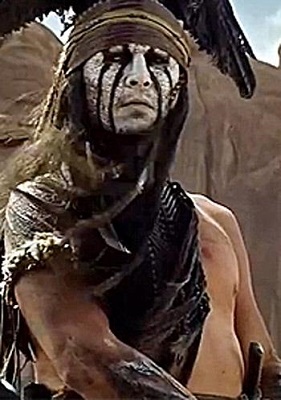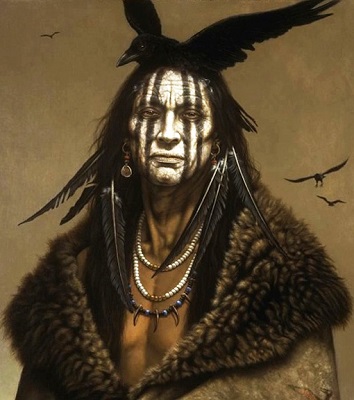 |
| Hollywood cast a Honky as Tonto; why act surprised that he's played as a Stage Indian? |
Director Gore Verbinski and producer Jerry Bruckheimer definitely imbued their story with good visuals. Armie Hammer’s black vest and matching duster look more plausible than Clayton Moore’s weird grey jumpsuit. The sweeping landscapes have a more unified look than the classic TV show’s set-bound appearance. Yet the creative team spent so much time and money on graphics that they forgot to care whether the characters made any damn sense.
When The Lone Ranger debuted on radio in 1922, a succession of white actors played Tonto. During the Depression, nobody flinched to hear white men grunting a supposedly Indian pidgin. But when the show graduated to TV, Native actor Jay Silverheels took especial pride in assuming the role. Silverheels represented not only a serious role model for the show’s child fans, but a step forward in how Hollywood treated Indians and Native concerns.
So when Disney announced a new Lone Ranger with a white actor as Tonto, audiences should have frankly expected blatant backsliding. This decision recalls years when studios trowelled “yellow” makeup on Anglo actors to create Charlie Chan. Studios love such characters, who require little thought or imagination. This blatant appeal to musty racial cliché, name-checking stereotypes as opposed to genuinely creating a character, signifies less racism than plain intellectual laziness.
 |
| Clayton Moore as the Lone Ranger; Jay Silverheels as Tonto |
Movies have suffered recently. Since The Sopranos lent panache to TV, visionary writers and directors have favored the small screen’s ability to build characters over an arc of years. Hardly the domain any longer of the priggish Standards and Practices prudes whose blue noses got bent if married couples slept in the same bed, TV now permits adventurous artists a chance to take bold risks on a years-long canvas.
This leaves the former Hollywood Dream Factories dominated by actors, whose bloated salary demands require studios to churn out blockbusters with factory regularity. No longer can Hollywood take risks on marginal properties like Casablanca or The Big Chill. Focus groups and market studies have incrementally neutered studios’ penchant for adventure. Anything lacking the requisite minimum share of explosions and CGI spectacles can’t justify its share of studios’ shrinking budget pie.
The audacious spirit that motivated movie entrepreneurs from Orson Welles to George Lucas has migrated to what filmmakers once called “the idiot box.” Thus, while TV nurtures smart, understated, psychologically diverse serial dramas like Orphan Black and True Blood, Hollywood mass-manufactures reboots, sequels, franchises, and adaptations. Comic books and discontinued TV properties rule. Disney openly speculates on Star Wars Episode VII, and true fans cringe.
Johnny Depp, once acknowledged for his constantly evolving range and emotional depth, has lapsed into a repetitive portrayal at least since 2005’s Charlie and the Chocolate Factory, if not earlier. The clownish mugging that characterizes his recent Tim Burton films pleases audiences and draws huge revenue, that justifies his obscene salaries. The quiet depth he once demonstrated just doesn’t pay as well, not for him or the studios.
 |
| Kirby Sattler's I Am Crow, the painting that inspired Tonto's new look |
We film buffs admire creative innovators, from Michael Curtiz to Kathryn Bigelow, who coax ensembles to achieve new, profound portrayals of complex situations. But Depp has joined the ranks of Hollywood personalities who must be appeased. Depp’s Tonto represents a studio system no longer interested in telling good stories for ambitious audiences. Disney’s Lone Ranger is the inevitable result of studios’ essential artistic exhaustion.
No comments:
Post a Comment